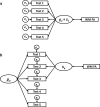Brain white matter tract integrity and cognitive abilities in community-dwelling older people: the Lothian Birth Cohort, 1936
- PMID: 23937481
- PMCID: PMC3780714
- DOI: 10.1037/a0033354
Brain white matter tract integrity and cognitive abilities in community-dwelling older people: the Lothian Birth Cohort, 1936
Erratum in
- Neuropsychology. 2013 Nov;27(6):701
Abstract
Objective: The present study investigates associations between brain white matter tract integrity and cognitive abilities in community-dwelling older people (N = 655). We explored two potential confounds of white matter tract-cognition associations in later life: (a) whether the associations between tracts and specific cognitive abilities are accounted for by general cognitive ability (g); and (b) how the presence of atrophy and white matter lesions affect these associations.
Method: Tract integrity was determined using quantitative diffusion magnetic resonance imaging tractography (tract-averaged fractional anisotropy [FA]). Using confirmatory factor analysis, we compared first-order and bifactor models to investigate whether specific tract-ability associations were accounted for by g.
Results: Significant associations were found between g and FA in bilateral anterior thalamic radiations (r range: .16-.18, p < .01), uncinate (r range: .19-.26, p < .001), arcuate fasciculi (r range: .11-.12, p < .05), and the splenium of corpus callosum (r = .14, p < .01). After controlling for g within the bifactor model, some significant specific cognitive domain associations remained. Results also suggest that the primary effects of controlling for whole brain integrity were on g associations, not specific abilities.
Conclusion: Results suggest that g accounts for most of, but not all, the tract-cognition associations in the current data. When controlling for age-related overall brain structural changes, only minor attenuations of the tract-cognition associations were found, and these were primarily with g. In totality, the results highlight the importance of controlling for g when investigating associations between specific cognitive abilities and neuropsychology variables.
Figures




References
-
- Bollen K. A. (1989). Structural equations with latent variables. New York, NY: Wiley.
MeSH terms
Grants and funding
LinkOut - more resources
Full Text Sources
Other Literature Sources
Medical

